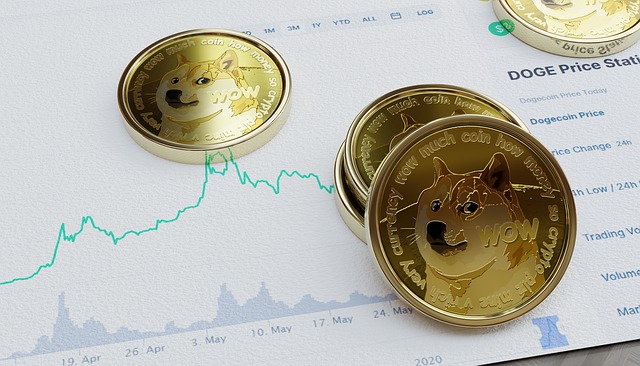Dogecoin (DOGE), created in 2013 by Billy Markus and Jackson Palmer as a "joke" currency, quickly gained popularity through its unique branding based on internet memes featuring the Shiba Inu dog. Its catchy slogans, playful tone, and emphasis on accessibility and community fostered a loyal following among "Dogefans," driving widespread adoption and making it a standout in the cryptocurrency landscape.
“The evolution of Dogecoin’s branding and marketing is a captivating journey that mirrors its meteoric rise in popularity. Since its inception, Dogecoin has transformed from a playful, meme-driven cryptocurrency to a global phenomenon, all while retaining its unique brand identity. This article delves into the early days of Dogecoin, when community and fun were paramount, tracing its adaptation to market demands and eventual global adoption. We explore strategic shifts, including positioning as a legitimate investment while preserving its lighthearted essence. Through social media engagement, influencer partnerships, and charitable causes, Dogecoin’s branding has successfully fostered a thriving global community.”
- The Early Days of Dogecoin: A Playful Brand
- – Discuss the inception of Dogecoin and its original branding as a lighthearted cryptocurrency with a focus on community and fun.
- – Highlight the use of dog memes and the Shiba Inu dog image, and how these contributed to its unique identity.
The Early Days of Dogecoin: A Playful Brand

In its early days, Dogecoin emerged as a playful and lighthearted brand, leveraging the popularity of the Shiba Inu dog meme. Created in 2013, this cryptocurrency was initially marketed as a “joke” currency, drawing inspiration from an internet meme that depicted a dog with an expression of pure joy. The creators, Billy Markus and Jackson Palmer, intended to satirize the frenzy surrounding cryptocurrencies at the time. The playful branding quickly gained traction, attracting a dedicated community of users who appreciated its humor and decentralized nature. This unique approach set Dogecoin apart from other currencies, establishing it as a fun and accessible digital asset.
The playful theme translated into various marketing strategies, including catchy slogans like “Doge for everyone!” and the iconic use of the Shiba Inu dog as the face of the coin. This branding effectively communicated Dogecoin’s user-friendly and inclusive nature, appealing to a broader audience beyond the typical crypto enthusiasts. As a result, Dogecoin fostered a sense of community and camaraderie among its followers, who often referred to themselves as “Doge miners” or simply “Dogefans.”
– Discuss the inception of Dogecoin and its original branding as a lighthearted cryptocurrency with a focus on community and fun.

Dogecoin, created in 2013 by software engineers Billy Markus and Jackson Palmer, emerged as a lighthearted alternative to mainstream cryptocurrencies. From its inception, Dogecoin was positioned as a fun, community-driven digital currency with a unique branding that tapped into internet culture. The initial marketing strategy revolved around dog memes, charming imagery of Shiba Inus (often referred to as “dogs”), and a playful tone that set it apart from the more serious nature of other cryptocurrencies. This approach not only created a memorable brand identity but also fostered a sense of camaraderie among its early adopters.
The original branding focused on accessibility, inclusivity, and entertainment value, which attracted users who saw Dogecoin as a casual investment or a means for online transactions with a twist. This playful branding became a cornerstone of the dogecoin community, leading to widespread adoption and a loyal following that continues to drive its popularity in the ever-evolving world of cryptocurrency.
– Highlight the use of dog memes and the Shiba Inu dog image, and how these contributed to its unique identity.

Dogecoin’s branding and marketing strategy have been significantly shaped by its unique visual identity, heavily influenced by internet memes and the iconic Shiba Inu dog. This playful and memorable imagery has become a cornerstone of the cryptocurrency’s appeal, especially to younger generations who are deeply ingrained in online culture. The Shiba Inu, with its curious expression and seemingly rebellious attitude, perfectly encapsulates the spirit of both the cryptocurrency and the broader crypto community—a community known for its skepticism, humor, and innovative thinking.
These memes and images have not only made Dogecoin instantly recognizable but have also fostered a sense of community among its users. The viral nature of these digital artifacts has helped to spread awareness about Dogecoin far and wide, contributing to its rapid growth and adoption. By leveraging the power of internet culture, Dogecoin has carved out a distinct niche in the competitive cryptocurrency market, solidifying its position as a standout and beloved digital asset.
As Dogecoin continues to evolve, its branding and marketing strategies have played a pivotal role in shaping its global impact. From its playful origins centered around community engagement and meme culture, Dogecoin has successfully navigated the cryptocurrency landscape by leveraging its unique identity. The integration of dog-related imagery and memes, notably the iconic Shiba Inu, has not only captured users’ attention but also fostered a sense of camaraderie among the community. As the crypto space expands, Dogecoin’s ability to blend humor, technology, and social interaction serves as a compelling model for effective branding in an increasingly competitive market.








Leave a Reply